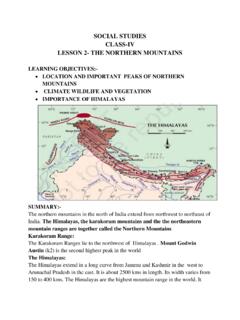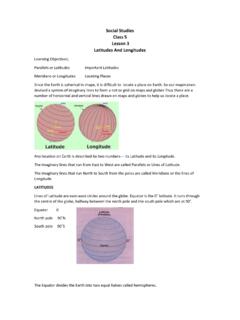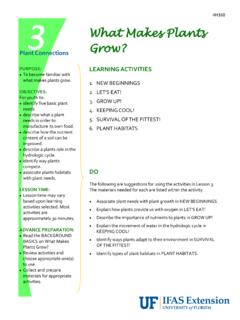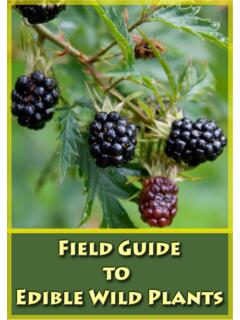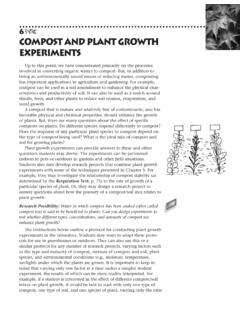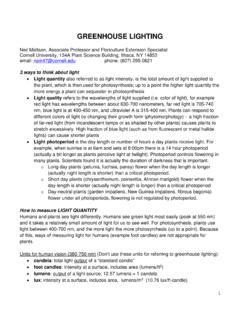Transcription of CLASS IV SCIENCE CHAPTER-2 ADAPTATIONS IN PLANTS
1 CLASS IV SCIENCE CHAPTER-2 ADAPTATIONS IN PLANTS PLANTS grow in difficult places. They can be found in dry and sandy deserts, damp and wet pants, hilly areas, valleys, snow covered high mountain and even under water. The place where an organism usually lives and grows in nature is called its habitat. It can be small as patch and large as forest. ADAPTATIONS are the special features that help a plant to survive in its habitat. PLANTS can be divided into major groups: (A) Water or aquatic PLANTS (B) Land or Terrestrial PLANTS . PLANTS that grow in water are called aquatic PLANTS .
2 There are two types of aquatic PLANTS - floating PLANTS , fixed PLANTS and underwater. Floating PLANTS : like duckweed, piste and water hyacinth are light and spongy. This makes PLANTS very light. Thus PLANTS able to float on the surface of water. Upper surface of leaves are waxy to repel water. Fixed PLANTS : have roots fixed to bottom of the river body such as pond. They have long stem to reach the surface of water. They broad leaves that float on water. They also have waxy have thin, hollow, flexible and light stems which help the leaves to also bend with the flow of water, thereby preventing damage by strong water current.
3 Eg.; water lily and lotus. Underwater PLANTS : are fixed to the bottom of the water body and remain fully underwater. Stomata are absent in supports the life of animals to great extent as they give out oxygen during ; Hydrilla and Pondweed. Land or Terrestrial PLANTS All PLANTS that grow on land are called terrestrial PLANTS or land PLANTS . PLANTS are growing in different kinds of land areas hence PLANTS needs various ADAPTATIONS . PLANTS in the Plains Some PLANTS grow in the plains where the climate is hot in summer and cold in winter. They have more area to spread.
4 They have flat leaves so water to evaporate and keep tree cool. Examples: Mango, banyan and peepal tree. Deciduous trees that loose all their leaves in autumn in order to survive harsh weather condition and new leaves start growing as spring approaches. Eg. Maple tree and cherry. Evergreen trees that do not loose their leaves at once. Eg. Jack fruit and pine. PLANTS in the Deserts Deserts are dry and very hot places. There is scarcity of rainfall and a lot of direct sunlight fall on the PLANTS . The soil in desert are sandy and unable to hold the water. Eg. Cactus and saguaro.
5 PLANTS store food in their stems or leaves. Long root system to go deep in to the ground. Most PLANTS are leafless hence help in reduce water loss. Prickly spines discourage animals from eating PLANTS for water. PLANTS in Montains PLANTS on hills are adapted to grow in very cold temperatures. Most PLANTS are tall and straight. Most PLANTS are needle like leaves. That prevents loss of water and shed the snow easily. Waxy coating on the leaves prevent evaporation and loss of water. Coniferous trees that do not bear flowers but have seeds in are called conifers and coniferous trees.
6 Eg Pine and fir. PLANTS in heavy rainfall Areas Evergreen trees are found in this region. The broad and abundant leaves capture sunlight for photosynthesis. Eg. Lychee and cashew. PLANTS along the sea coast Trees in the coastal areas are well adapted to grow in sandy soil, salty water and high rainfall. They have strong stem that can withstand strong winds. They have long roots that grow deep into the sandy soil. Coconut and palm trees grow well in these areas. PLANTS in Marshy or Swampy Areas They have sticky and clayey soil. It is difficult for PLANTS to grow in such areas as air cannot reach the roots.
7 Thus, roots of these grow out of the soil to breathe from the air. Such roots are called Breathing roots. Trees growing in marshy areas are called mangroves. Eg. Rhizophora and Avicennia. EXERCISES OBJECTIVE TYPE QUESTIONS A Give two examples of the following: PLANTS .. PLANTS .. in deserts .. in mountains .. in heavy rainfall area .. B Choose the correct option. and spongy water PLANTS like .. can float on the surface of the water. A) mangroves B) duckweed C) lotus D) cactus.
8 2. Coconut trees grow well in .. areas. A) desert B) swampy C) coastal D) hilly. 3.. is an underwater plant. A) eelgrass B) water lily C) lotus D) duckweed 4. These trees usually have wax coating to prevent evaporation and loss of water. A) fir B) hydrilla C) coconut D) mangrove 5. PLANTS in heavy rainfall areas are .. A) cotton, sugar cane B) sundew, pitcher plant C) Indian pipe, fir D) mango, pine C. Fill in the blanks. PLANTS such as pondweed and eelgrass have narrow leave without .. PLANTS like duckweed and pista have lots of empty spaces filled with air.
9 , pepal and sheesham are some trees that grow in .. system in desert PLANTS go deep into ground to absorb the available water . of some PLANTS that grow out of the soil to breathe from air are called .. roots. D. Write T for True statements or F for False statements. terrestrial PLANTS grow in water. cactus plant stores water in its stem. PLANTS do not shed their leaves at once. protect cactus from animals. trees in heavy rainfall areas are called conifers. E. Match the following: THEORETICAL QUESTIONS the following questions in brief. is a habitat? does long root system help desert PLANTS ?
10 Do mountain PLANTS have waxy coating on leaves? coniferous trees. Give two examples. are breathing roots? B. Answer the following questions in detail. some adaptation in desert plant. do plant in marshy areas survive ? Explain. 1 Floating plant peepal2 PLANTS in the plainsEelgrass3 Underwater plant Teak tree4 Deciduous trees Coconut5 Plant in coastal areaWolffiaC. Draw cactus plant and label its ADAPTATIONS . ANSWERS QA 1- Duckweed and water hyacinth 2- Pondweed and Eelgrass 3- Cactus and saguaro 4- Deodar and pine 5- Cashew and pineapple QB 1-(b), 2- (c), 3-(a), 4-(a), 5-(a) QC 1- stomata 2-floating 3-plains 4-root 5-breathing QD 1- False, 2- True, 3-True, 4-True, 5-False QE 1-(e), 2-(c), 3-(a), 4-(b), 5(d) THEORITICAL QUESTIONS QA place where an organism usually lives and grows in nature is called its habitat.
